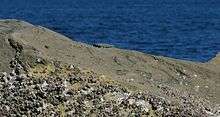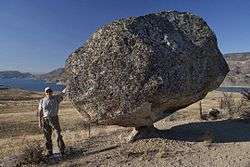Haleets
Haleets (also called Figurehead Rock) is a sandstone glacial erratic boulder[1][2] with inscribed petroglyphs on Bainbridge Island, Washington. The Native American Suquamish Tribe claims the rock, on a public beach at Agate Point on the shore of Agate Passage, as part of their heritage.[2] The exact date the petroglyphs were carved is unknown but is estimated to be around 1000 BCE to 400 or 500 CE, the latest date being when labrets (worn by one of the petroglyph figures) were no longer used by Coast Salish peoples.[3][4]
| Glacial erratic rock | |
Haleets at low tide. Most of the petroglyphs are concealed beneath barnacles. | |
| Coordinates | 47°43′07.1″N 122°32′40.1″W |
|---|---|
| Composition | |
| Sandstone | |

Haleets is the Coast Salish name of the rock, also transcribed as Halelos, Xalelos and Xalilc, meaning "marked face".[5] It is known in English as Figurehead Rock. Its purpose is unknown but the Suquamish Museum curator and archivist Charlie Sigo has stated that it may have been a boundary marker.[6] An amateur astronomer has proposed a theory that it has a calendrical function (see Archaeoastronomy).[2][6][7][notes 1]
The rock is 5 feet (1.5 m) tall and 7 feet (2.1 m) long. It sits about 100 feet (30 m) offshore,[6] and has been marked with chiseled and drilled coast survey features since 1856, and a bronze geodetic mark was placed on it in 1934.[8] Some sources say that the rock is one of three prominent Salish Sea petroglyphs that were always on the shoreline,[9] but tectonic activity around the Seattle Fault may have put Haleets in the intertidal zone.[notes 2]
Footnotes
- Bainbridge Island Historical Museum 2012: "The petroglyph lies precisely west of the Skykomish canyon 60 miles away. Standing at the petroglyph on the vernal and autumnal equinox, one can view the rising sun shining straight through the canyon."[3]
- Alcalá 2013: "Within human memory, Laxelks, now called Wing Point, fell about three feet during an earthquake."[5]
References
- Sources
- Lewarch, Dennis (October 2012), "Preserving Haleets: a Suquamish Treasure" (PDF), Suquamish News, Suquamish Tribe, archived from the original (PDF) on 2012-12-15
- Beauchamp, Douglas (2013), "Puget Sound Petroglyph Boulders: Rock Art in the West", Rock Art Oregon, Eugene, Oregon
- Westbrook, Todd (April 4, 1999), "Did Rock Carvings Mark The Seasons?", The (Bremerton) Sun – via The Seattle Times
- Alcalá, Kathleen (February 3, 2013), "The Salish Sea II", Kathleen Alcalá Newsletter, p. 3, archived from the original on April 9, 2016, retrieved April 24, 2015
- "1000 BC to 500 AD — The Agate Point petroglyphs are carved", It's About Time: a Chronological Timeline of Events on Bainbridge Island, Bainbridge Island Historical Museum, 2012
- Leen, Daniel (2015), "Puget (Lushootseed) Salish sites", A Gallery of Northwest Petroglyphs: Shamanic Art of the Pacific Northwest
- "Mysteries of the petroglyph", Bainbridge Island Review, June 9, 2008, archived from the original on March 5, 2016
- Casey, Rob (2012), Kayaking Puget Sound and the San Juan Islands: 60 Paddle Trips Including the Gulf Islands, The Mountaineers Books, ISBN 9781594856853
- Survey marker SY5096 NGS data sheet, United States National Oceanic and Atmospheric Administration (NOAA), April 24, 2015

